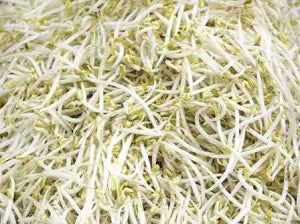I remember as a child seeing my step-mother grow alfalfa sprouts in the kitchen in a mason jar. She would put on them on her sandwiches and salads. As a child, I never knew how much I would grow to appreciate these fresh tasting sprouts as much as I do today. Now, I want to learn how to grow them myself so I can appreciate it even more. Are you interested? Keep reading to find out!
What are Vegetable Sprouts?
They are the plant’s first tender stems that emerge from the seed. Just about any seed can be germinated for this purpose, but some are more common than others. Some common vegetable sprouts include: broccoli, mustard, radish, onion and chive. From what I’ve already learned, some of the flavors you receive from these little sprouts can be quite explosive in taste. So, naturally I can’t wait to experiment with them. For instance, if you enjoy a little heat, you would probably like radish sprouts. Mustard sprouts offer a spicy accent to your meal, while broccoli sprouts offer a mild peppery flavor. And onion sprouts offer a flavor similar to its adult plant without the crying to accompany it.
What are the Health Benefits of Vegetable Sprouts?
They are loaded full of vitamins and minerals, such as vitamins A, B, C, E and K; iron, calcium, potassium and zinc. These sprouts are also packed with amino acids, proteins and antioxidants. According to The International Sprout Growers Association, a powerful cancer fighter, sulforaphane, is proven to be packed in broccoli sprouts. While radish sprouts have 29 times more vitamin C than milk and 4 times the vitamin A. That’s just naming a few of the outstanding health statistics associated with these little sprouts.
Growing Vegetable Sprouts
Using a wide mouth mason jar, add 1 part seeds to 3 parts non-chlorinated water (treated water can affect sprouting). Cover with a fine mesh screen or cheesecloth and secure with a rubber band. Soak the seeds for 8-12 hours in a cool place, out of direct sunlight. Rinse the seeds thoroughly and drain. Repeat rinsing the seeds four times a day until sprouting while storing the seeds in a shaded place. Between the third and tenth day should generate sprouts, depending on the variety of seed. Once sprouting has occurred, rinse and drain the sprouts. Expose the seeds to sunlight. Once the sprouts have leaves and have turned green, they are done. For best flavor, it isn’t recommended to allow the sprouts to grow longer than 4 inches.
Final Thoughts
- For best freshness, keep in the vegetable crisper of your refrigerator. Rinse with cold water daily and dry before returning to the refrigerator.
- Sprouts should be eaten within three days of sprouting.
- Avoid conventional garden seeds, because most of these seeds have been treated with pesticides and fungicides.
- Since sprouts are grown in a warm environment, they are susceptible to food poisoning. Be sure to eat them while they are fresh.



